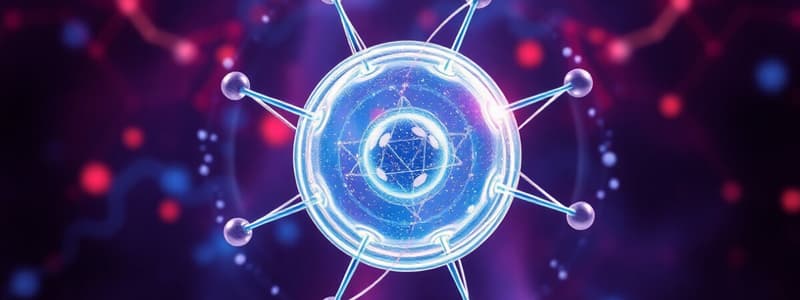Podcast
Questions and Answers
Which of the following factors primarily determines the size of an atom?
Which of the following factors primarily determines the size of an atom?
- The number of electrons in the atom
- The number of protons in the nucleus
- The energy level of the highest occupied orbital
- The effective nuclear charge experienced by the outermost electrons (correct)
Electronegativity generally increases as you move from left to right across a period in the periodic table.
Electronegativity generally increases as you move from left to right across a period in the periodic table.
True (A)
Explain the concept of ionization energy and how it varies within a group in the periodic table.
Explain the concept of ionization energy and how it varies within a group in the periodic table.
Ionization energy is the minimum energy required to remove an electron from a gaseous atom in its ground electronic state. Ionization energy generally decreases as you move down a group in the periodic table. This is because the outermost electrons are further away from the nucleus with increasing shell number, experiencing weaker attraction, making it easier to remove them.
The tendency of an atom or ion to distort the electron cloud of a neighboring atom or ion is known as ______.
The tendency of an atom or ion to distort the electron cloud of a neighboring atom or ion is known as ______.
Match the following periodic properties with their corresponding definitions:
Match the following periodic properties with their corresponding definitions:
Flashcards
Effective Nuclear Charge
Effective Nuclear Charge
The net positive charge experienced by an electron in a multi-electron atom.
Ionization Energy
Ionization Energy
The energy required to remove an electron from an atom in its gaseous state.
Electron Affinity
Electron Affinity
The energy change that occurs when an electron is added to a neutral atom.
Electronegativity
Electronegativity
Signup and view all the flashcards
Atomic Radius
Atomic Radius
Signup and view all the flashcards
Study Notes
Periodic Properties
- Effective Nuclear Charge: The net positive charge experienced by an electron in an atom, taking into account the shielding effect of inner electrons. This charge influences atomic size, ionization energy, and other properties.
Atomic Structure and Orbital Energies
- Orbital Penetration: Inner electrons, especially s electrons, penetrate closer to the nucleus, shielding outer electrons less effectively, influencing trends in atomic properties.
- Orbital Energies (s, p, d, f): The energies of different electron orbitals (s, p, d, f) in atoms vary and influence electronic configurations. Specific trends exist within the periodic table.
- Electronic Configurations: The arrangement of electrons in atomic orbitals follows specific rules (Aufbau principle, Hund's rule, Pauli exclusion principle) and dictates the chemical behavior of elements.
Atomic and Ionic Sizes
- Atomic Size Trends: Atomic size generally decreases across a period (left to right) due to increased effective nuclear charge and increases down a group (top to bottom) due to increasing principal quantum numbers.
- Ionic Size Trends: Cations are smaller than their parent atoms, while anions are larger. These trends in ionic size relate to the gain or loss of electrons and changes in effective nuclear charge.
Ionization Energies and Electron Affinity
- Ionization Energy: The energy required to remove an electron from a gaseous atom or ion. Ionization energy generally increases across a period and decreases down a group.
- Electron Affinity: The energy change associated with adding an electron to a gaseous atom or ion. Electron affinity is generally more negative (exothermic) across a period, and less negative down a group.
Electronegativity and Polarizability
- Electronegativity: A measure of an atom's ability to attract shared electrons in a chemical bond. Electronegativity generally increases across a period and decreases down a group.
- Polarizability: The ability of a molecule or atom to have its electron distribution distorted by an external electric field. Larger atoms and molecules are generally more polarizable.
Oxidation States and Hard-Soft Acids and Bases
- Oxidation States: The hypothetical charge an atom would have if all bonds were completely ionic.
- Hard-Soft Acids and Bases (HSAB): A concept to categorize species as hard or soft based on their properties, including charge density and polarizability, which influences the reactions between acids and bases.
Molecular Geometry
- Molecular Geometries: The three-dimensional arrangement of atoms in a molecule, which is influenced by the number of bonding and lone electron pairs around a central atom. This affects the molecule's polarity and reactivity.
Studying That Suits You
Use AI to generate personalized quizzes and flashcards to suit your learning preferences.




